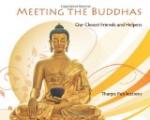They are not afraid of the dark. It hides them from their enemies. So when the sun has gone down and night comes, they fly up into the air and start on their journey.
If you should look through a telescope at the moon some clear night in spring or autumn, you could probably see the birds flying by. They look like bees going across the face of the moon.
Large birds, like ducks, fly very swiftly. It is thought that they may travel one hundred miles an hour. But the small warblers and flycatchers go less than half as fast.
Most birds that fly at night are far above the earth. They go as high as two or three miles. If you have ever been on a mountain top or a very high building, you will know how much farther you can see than when you are on the ground.
So the birds, too, can see a great distance as they fly by, high in the air. At night they can see the water sparkling in the starlight. This helps them to find their way.
When it is foggy or raining they cannot see which way they are going This is a sad time for the little feathered travelers. Some fly far out to sea and are drowned. The feathers of some are so wet that they cannot fly. Then they must seek shelter in the trees.
In wet and foggy weather the birds sometimes fly to the lighthouses. The light seems to attract them, just as a light attracts moths. They fly against the glasses which protect the light, and often are killed.
Sometimes large birds fly through the glass about the light. The light-keeper therefore puts wire netting outside the glass to protect it from these large birds.
While the birds are traveling at night they often call and chirp to each other. This keeps them from being lonely and from getting lost. If you should listen very carefully some still night in September, you might hear the birds calling as they fly swiftly by.
When morning comes the birds fly down to earth. Would you not think that they would be very tired after flying all night? They do not seem to be. But they are hungry, and as soon as they alight they begin to look for something to eat.
After breakfast they rest for a few hours. In the afternoon they go out for supper, for they must have a good meal if they are to fly again all night.
WHEN THE BIRDS RETURN.
How pleasant it is to hear the song of the robin on a March morning! At the first sign of spring he comes back to us from his winter home in the South. His cheerful song tells us that winter will soon be gone. In a few weeks we can look for wild flowers, and the fields will be green again.
The blackbirds follow a few days later. With a merry, jingling chorus they perch in the leafless trees. We know now that soon there will be leaves and blossoms, and the thought makes us glad.
Now we may look for the bluebird also. His soft, sweet warble is one of the most welcome of the springtime sounds. See him looking at the box in which last year he had a nest! Probably he is planning repairs. How happy he seems!




